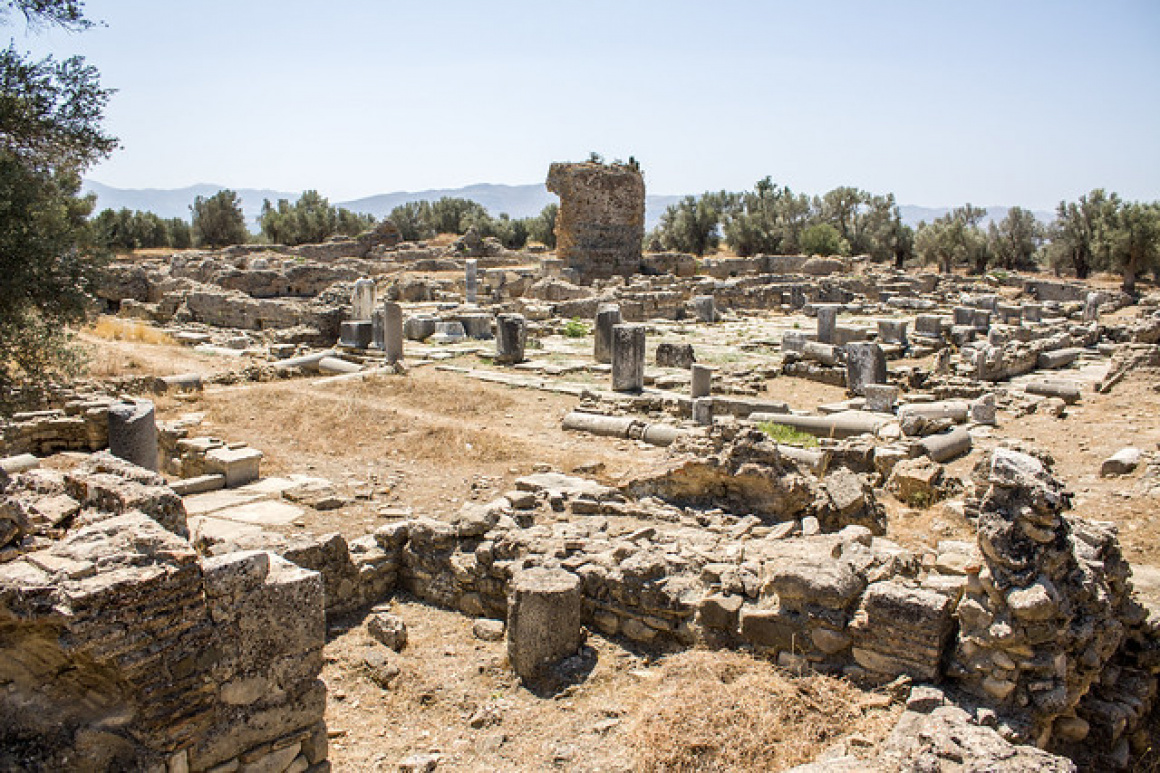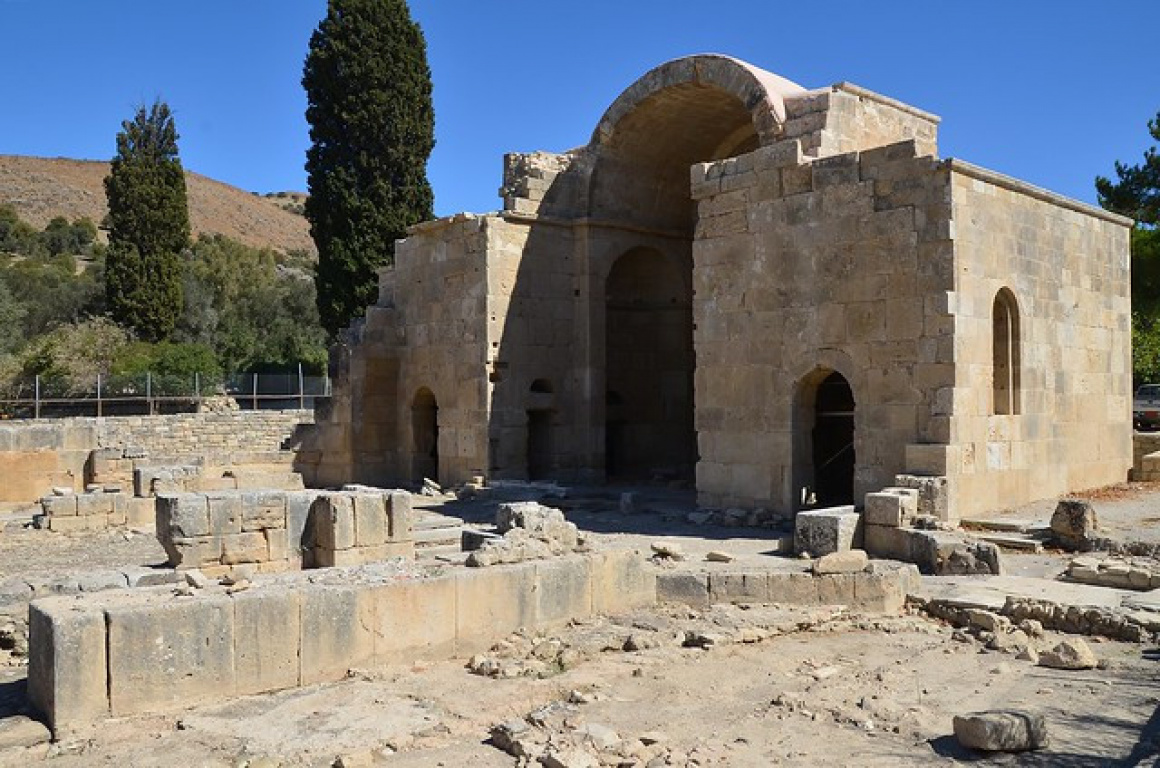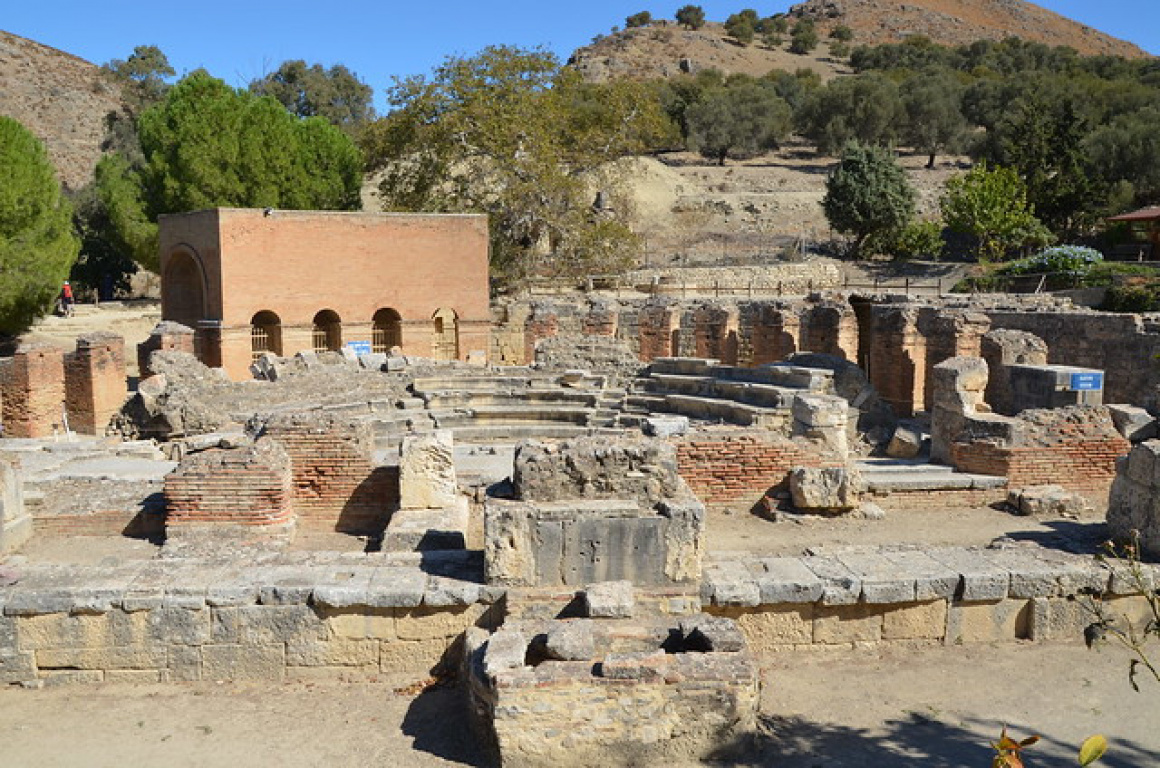Introduction
Scattered among the olive groves of southern Crete lie the atmospheric Gortyna Ruins (also spelled Gortyn or Gortys). At first glance, Gortyna might seem like just another set of tumbled stones and broken columns in a farmer's field. But this site holds secrets that span millennia – from mythical rendezvous of gods, to one of Europe's earliest written law codes, to grand churches of early Christianity. Walking through Gortyna is a bit like stepping into an open-air history book. You might find yourself all alone with crickets chirping and the scent of wild thyme in the air, turning a corner to suddenly face a massive inscribed wall or the crumbling arch of a Roman theater. Unlike more crowded sites, Gortyna has a quiet magic. Here, you have the space to imagine ancient lawmakers debating under a sycamore tree, or to hear in your mind's ear the roar of a crowd in the odeon. Gortyna isn't just one era – it's a palimpsest of Minoan, Greek, Roman, and Byzantine chapters of Crete's story, all waiting to be discovered under the Cretan sun.
A Mythical Tryst and the Birth of Europe
Long before Gortyna became a political and legal center, it was already famous in Greek mythology. According to legend, it was in the lush meadows of Gortyna that the Greek god Zeus, disguised as a magnificent white bull, brought the Phoenician princess Europa after abducting her from her homeland. Under the shade of a large plane tree by the riverside, Zeus revealed his true form and seduced Europa, and from their union the lineage of Cretan kings was born. In fact, Europa gave her name to the continent – a mythic way of saying that European civilization begins on Crete. At Gortyna, locals will point out an ancient plane tree near the ruins, said to be the very tree that witnessed Zeus and Europa's affair. Uniquely, this plane tree is evergreen – it never sheds its leaves, unlike almost all others of its kind – an eternal symbol of that divine encounter. Standing beneath its branches, one can almost sense the magic; it's a spot where myth and reality blur in a very tangible way.
From Minoan Outpost to Roman Capital
Historically, Gortyna (or Gortyn) was inhabited since Minoan times (as evidenced by some nearby Minoan remains), but it truly rose to prominence in the first millennium BC. By the Classical and Hellenistic periods, Gortyna became one of Crete's most powerful city-states, often in rivalry with Knossos. Its strategic position in the fertile Messara Plain and control of harbors like Lentas or Matala made it thrive on agriculture and trade.

 'Ancient Gortyna' - Attribution: Shadowgate
'Ancient Gortyna' - Attribution: ShadowgateGortyna's most illustrious era came with the Romans. In 67 BC, Crete was conquered by Rome, and Gortyna was rewarded for siding with the Romans early on. The city became the capital of the Roman province of Creta et Cyrenaica, ushering in a boom: Gortyna expanded dramatically, building grand avenues, theaters, baths, and temples. At its peak, it's estimated that tens of thousands lived here, making it the largest urban center in Crete during Roman times. To put it in perspective, while much of Europe languished on the fringes of the Roman Empire, Gortyna enjoyed fountains with running water and an amphitheater echoing with Latin-accented oratory.

 'Roman Theatre of Gortyn, Crete' - Attribution: Andrew and Annemarie
'Roman Theatre of Gortyn, Crete' - Attribution: Andrew and AnnemarieGortyna continued to be important into early Byzantine times. In the 4th century AD, as the Roman Empire transitioned to Christianity, Gortyna became a key Christian center. The city was the seat of the first Bishop of Crete, Apostle Titus (a disciple of Paul). The impressive ruins of the Basilica of St. Titus are still visible – a 6th-century church that was one of the largest in Greece at the time. Its crumbled apse and huge fallen capitals indicate a monumental structure, once adorned with marble. This church underscores Gortyna's status as not just a political capital, but a spiritual one as well.

 'The 6th century Byzantine church dedicated to St. Titus, the first Bishop of Crete who was appointed by the Apostle Paul, Gortyna, Crete' - Attribution: Following Hadrian
'The 6th century Byzantine church dedicated to St. Titus, the first Bishop of Crete who was appointed by the Apostle Paul, Gortyna, Crete' - Attribution: Following HadrianUltimately, Gortyna's story came to an end in AD 828, when invading Arab forces sacked the city (after Crete fell to them). The city was left in ruins and never fully rebuilt, its role eclipsed by the rise of Heraklion under Arab rule. Over the centuries, earthquakes and the steady creep of nature buried much of Gortyna. What remains today are pieces of each era, puzzle parts across olive fields, telling a tale of rise and fall.
Exploring the Site
Unlike a neatly enclosed archaeological park, Ancient Gortyna is spread out across several zones, divided by a modern road. The official archaeological site (ticketed area) covers the Law Code Odeon and some surroundings, but many ruins lie open in the fields beyond, which you can explore freely.
Start at the main entrance by the Odeon, where you pay a small fee to enter the central site. Immediately, you'll see the famed Law Code Inscription. It's protected by a roof (to preserve the stones) and some fencing, but you can get close enough to clearly read the ancient Greek letters (if you can read archaic Greek, that is!). Even if not, the sheer size and detail are astonishing – 12 columns of text, each line running right-to-left then left-to-right alternately. One corner of the wall was actually damaged, but luckily French archaeologists in the 19th century had copied the text, so nothing was lost to scholarship. Take a moment to appreciate this was essentially a public bulletin board of laws for citizens some 2,500 years ago.
Adjacent to the inscription is the Odeon structure itself. You can sit on the stone benches where local elites or Roman dignitaries once sat for performances or perhaps legal proceedings. The stage and some columns are partially reconstructed. Here, imagine an orator reciting poetry or a musician plucking a lyre, with the city's educated class gathered in a small, intimate setting. It's quite shaded and pleasant, thanks to trees that have grown around.
Next, stroll over to the ruins of the Temple of Apollo (signposted within the site). Only the foundation and scattered stones remain, but an informative sign illustrates what it may have looked like. Nearby, you'll notice a jumble of artifacts: inscribed stones, pieces of statues, capitals. Gortyna has yielded countless treasures, many of which are displayed in the Heraklion Archaeological Museum. But a few copies and less fragile pieces remain on site to give context.

 'Ancient Gortyna' - Attribution: Shadowgate
'Ancient Gortyna' - Attribution: ShadowgateExiting the fenced area, don't miss the Basilica of Saint Titus directly across the road. This part is open access. Walk among its ruins – you can see the outline of the church, the apse where the altar stood, and a few restored arches. In the late afternoon light, the stones of the basilica take on a warm glow and the swallows darting through the remaining archways make it very picturesque. A large statue of the apostle Titus once stood here; today, locals still revere Titus, and you might find wreaths or candles left by pilgrims.
Continue a bit further and you encounter the partially reconstructed Roman columns and stone archway that mark what was once the Praetorium or forum area. Beyond, among the trees and fields, lie further pockets of ruins: a stadium site (not much to see now), more house foundations, and the nymphaeum – a sanctuary of the nymphs and water, likely part of the bath complex. The beauty of Gortyna is that you can walk in the shade of ancient olive trees and literally stumble on a carved statue base or a chunk of mosaic peeking through the grass. It feels like an active archaeological dig, which in some ways it still is – excavations continue periodically.
One particularly charming spot is the area around the mythic Plane Tree of Zeus and Europa. It's just behind the Basilica, near a trickling spring. Unlike most plane trees, this one doesn't lose leaves in winter – a botanical anomaly attributed to Zeus's blessing. There's usually a wooden sign identifying it. Pause here and consider the myth: a god's union with a mortal that sired King Minos and ultimately, through that lineage, all of Crete's civilization. In a symbolic sense, Gortyna truly is where Europe (the continent) got its name and some of its earliest laws.
Because the site is so large, allow a good couple of hours if you want to explore thoroughly. There is a lot to take in, but also plenty of spots to just sit on an ancient stone under an olive tree and absorb the atmosphere. Gortyna doesn't force itself upon you with spectacle; it reveals itself slowly, as you wander from one cluster of ruins to another.
Visiting Information and Tips
Location: Gortyna is in the south-central part of Crete, in the Messara Plain. It's about 45 km (28 mi) southwest of Heraklion. By car, the drive takes around 50 minutes to an hour. The route is straightforward: you head toward Agioi Deka or Moires following signs for Gortyna (or “Gortys”). Public buses from Heraklion towards Moires or Timbaki can drop you at Agioi Deka village, from where it's a short walk to the ruins.
Entrance & Hours: The central archaeological site (Odeon/Law Code area) has an entry fee of about €6 (or combined ticket with Phaistos for a bit more). The site is typically open from 8:30 to 15:30 (last entry) on most days except holidays, with longer hours in summer (sometimes until 18:00). However, keep in mind that large parts of Gortyna (like the Basilica, plane tree, etc.) are unfenced and accessible at any time, freely. It's worth stopping by even after hours to stroll the open areas – just be respectful and cautious as there's no lighting at night.
Amenities: Near the ticket booth, there's a small canteen (in season) selling drinks and snacks, and usually a WC for visitors. Don't expect a full café or museum on site – there used to be a tiny museum but it's currently closed (most significant finds went to the museum in Heraklion). Wear good shoes, as you'll be walking on uneven terrain and through some brush if exploring the outer ruins. A hat, water, and sunscreen are musts in summer; Gortyna can be very hot and the open ruins reflect the sun. In spring, the area is lush and green, but by July it's dry and sun-baked.
Touring Tips: If you have visited the more famous sites like Knossos or Phaistos Palace first, coming to Gortyna is a different experience – there are far fewer explanatory signs and no obvious tour route. This is part of its charm. However, to get the most out of it, consider reading up beforehand or having a guidebook app or pamphlet. Some guided tours from Heraklion include Gortyna as part of a day trip with Phaistos and Matala Beach, which can be worthwhile for the historical commentary. If going solo and you see a group with a guide, hanging back and catching a few tidbits (without being intrusive) can sometimes enhance your understanding.
Nearby: Combine Gortyna with a trip to Phaistos Palace (about 20 km to the south) to cover both the Roman and Minoan capitals of the Messara region in one go. Also, the quaint village of Agioi Deka (which literally means “Ten Saints”) adjacent to Gortyna is named after ten Christian martyrs who were executed at Gortyna during Roman persecutions. The village has a beautiful little church and a very local vibe. Don't miss trying some local yogurt with honey or a Greek coffee at the kafeneio in the village square. A further idea: after exploring the ruins, drive 15 minutes south to Matala Beach on the coast for a refreshing swim – a perfect way to cool off, and a drastic change of scenery from ancient stones to deep blue sea.
Unique Insights
One thing that sets Gortyna apart is how intertwined it is with present-day rural life. As you roam, you might see farmers pruning olive trees or hear sheep bells in the distance. Parts of the site lie on private agricultural land. In fact, the famous law code itself was discovered by accident when, in the 1880s, an ox stumbled into a pit revealing buried stones carved with writing! This blend of past and present means new discoveries still happen – occasionally heavy rains uncover a new mosaic or inscription. Gortyna feels like a living puzzle, only partly unearthed.
Also, consider the significance of that law code. It's humbling to realize that over 2,500 years ago, in this very spot, people were forward-thinking enough to write down their laws publicly, striving for a transparent justice system. Concepts like property rights for women and rules for adoption in that code were virtually unheard of elsewhere at the time. In a sense, Crete was ahead of the curve – a birthplace not only of the mythic Europa, but of European legal tradition and a civilized rule of law.
When you visit Gortyna, you're not just ticking off another ruin. You're connecting with layers of human experience – from Zeus's mythical love story to Roman governors stamping official seals, to Christian bishops chanting hymns in a basilica. Give yourself the freedom to explore and daydream here. In the gentle silence of Gortyna's fields, history isn't a dry subject; it's an imaginative journey. (Interested in Minoan history? Head over to our Phaistos Palace page for Bronze Age marvels, or for another off-the-beaten-path site, see Zakros Palace in eastern Crete. And if you're headed towards Matala after Gortyna, check out our tips on Best Sunset Spots – Matala's sunsets are legendary.)


